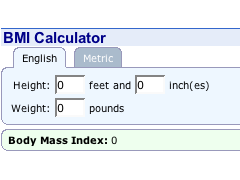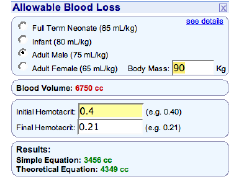Thursday, April 20, 2006
Identity Theft Disclosure Law: Congress About To Fail Us Again
-
Printer Friendly|#| Trackback
Bruce Schneier, in Identity-Theft Disclosure Laws explains why pending federal legislation on protecting consumers form identity theft is a step backward from many existing state laws.
"...this federal law pre-empts the 23 existing state laws -- and others being considered -- many of which contain stronger individual protections. So while [the Data Accountability and Trust Act] might look like a law protecting consumers nationwide, it is actually a law protecting companies with large databases from state laws protecting consumers.
So in its current form, this legislation would make things worse, not better."
Tuesday, April 11, 2006
Two New Google Modules
-
Printer Friendly|#| Trackback
Seth Dillingham and I have created two modules for the Google personalized home page : Allowable Blood Loss and BMI Calculator. Despite having been submitted a week ago they are still not included in their directory, but I thought it safe to post about them here....
 |
BMI calculates the Body Mass Index using the US or metric system. Furthermore, it can be used to convert from one system to the other.

|
 |
The Allowable Blood Loss Calculator gives a fairly good estimate of how much blood a patient would have to lose to cause a drop in hematrocrit to a specified amount assuming euvolemia is maintained.

|
Pet Peave: popular press articles that don't link to their sources
-
Printer Friendly|#| Trackback
The New York Times Online has an article titled 'Blasting of Kidney Stones Has Risks, Study Reports'. The article mentions the journal (The Journal of Urology) and the first author (Dr. Amy Krambeck). Would it have been so difficult to link to the abstract in the online version?
" SWL has revolutionized the management of nephrolithiasis and it is a preferred treatment for uncomplicated renal and proximal ureteral calculi. Since its introduction in 1982, conflicting reports of early adverse effects have been published. However, to our knowledge the long-term medical effects associated with SWL are unknown. We evaluated these adverse medical effects associated with SWL for renal and proximal ureteral stones.
Materials and Methods
Chart review identified 630 patients treated with SWL at our institution in 1985. Questionnaires were sent to 578 patients who were alive in 2004. The response rate was 58.9%. Respondents were matched by age, sex and year of presentation to a cohort of patients with nephrolithiasis who were treated nonsurgically.
Results
At 19 years of followup hypertension was more prevalent in the SWL group (OR 1.47, 95% CI 1.03, 2.10, p = 0.034). The development of hypertension was related to bilateral treatment (p = 0.033). In the SWL group diabetes mellitus developed in 16.8% of patients. Patients treated with SWL were more likely to have diabetes mellitus than controls (OR 3.23, 95% CI 1.73 to 6.02, p <0.001). Multivariate analysis controlling for change in body mass index showed a persistent risk of diabetes mellitus in the SWL group (OR 3.75, 95% CI 1.56 to 9.02, p = 0.003). Diabetes mellitus was related to the number of administered shocks and treatment intensity (p = 0.005 and 0.007).
Conclusions
At 19 years of followup SWL for renal and proximal ureteral stones was associated with the development of hypertension and diabetes mellitus. The incidence of these conditions was significantly higher than in a cohort of conservatively treated patients with nephrolithiasis. "
Before people panic (or call lawyers), please consider that this is one study, retrospective, with a 59% response rate, using older lithotripsy technology (as the NYT article points out, modern machines use less energy and are able to focus it more precisely.
Thursday, April 6, 2006
I'm 41....and free of student loan debt!
-
Printer Friendly|#| Trackback
I turned 41 years old today. Perhaps more significant to me, however, is that I finally paid off my last outstanding student loan! I finished medical school in 1992 and residency in 1996 so it took about ten years.
My total debt amounted to about $70,000 for college and medical school combined (without interest). Here are some interesting numbers from back then:
"Median U.S. Medical Schools Tuition and Fees for First-Year Students in 1992-3:
- $20,597 for private schools
- $7,544 for in-state residents at public schools
- $16, 739 for out-of-state residents at public schools
Mean level of Educational debt of indebted graduates in 1992:
- 19.5% of medical students had no debt
- $47,088 for public schools
- $69,479 for private schools
"
And here's the data from 2003:
"Average Educational Debt
- $115,218 – According to the Association of American Medical Colleges, the average educational debt of indebted graduates of the class of 2004 (including pre-med borrowing)
- 63% of graduates have debt of at least $100,000
- 81.4% of graduating medical students carry outstanding loans, combined with 62.4% with loans on college/premedical education
- $91,438 – Mean per capita debt for 2003 allopathic graduates
- $109,457 – Mean per capita debt for 2003 allopathic graduates excluding students without loans
- $123, 800 – Mean per capita debt for 2003 osteopathic graduates, up 2.3% from the previous year
- $7,277 – non-educational debt (allopathic)
"
One final note: If I'd stayed in academic anesthesia it would have taken at least another ten years to pay these loans off...
Wednesday, April 5, 2006
Air Force Anesthesia: Ether and Pentothal?
-
Printer Friendly|#| Trackback
The U.S. Air Force physician recruitment web site has a web page for anesthesiologists which claims I can "administer such anesthetics as ether, sodium pentathol and nitrous oxide while maintaining life support of patients under your care."
Since ether hasn't been used in decades and few practicing anesthesiologists know how to administer it, that would explain why I'd have to "maintain life support of patients under [my] care." Seriously, doesn't anybody read this stuff before they post it on their site? There's not a single fact on that page to help me decide whether I'd like to learn more or 'contact an Air Force Advisor today.'
Tuesday, March 14, 2006
Wisconsin Limits Noneconomic Damages In Malpractice Suits
-
Printer Friendly|#| Trackback
Wisconsin Senate Approves Limits On Noneconomic Damages In Malpractice Suits:
"The Wisconsin state Senate on Wednesday voted 25-8 to approve a bill that would place a $750,000 limit on noneconomic damage awards in medical malpractice cases, the Milwaukee Journal Sentinel reports. Six Democrats joined all 19 Republicans in voting for the bill."
[Via UK Medical News Today]
Sunday, March 5, 2006
Vaccines, Mercury, and Autism--New Data
-
Printer Friendly|#| Trackback
My smart wife tells me that this article is really big news: Early Downward Trends in Neurodevelopmental Disorders Following Removal of Thimerosal-Containing Vaccines (pdf). I've quoted the entire abstract below:
"Contemporaneously with the epidemic rise in neurodevelopmental disorders (NDs), first observed in the United States during the 1990s, the childhood immunization schedule was expanded by the U.S. Centers for Disease Control and Prevention (CDC) to include several additional thimerosal-containing vaccines (TCVs). On July 7, 1999, a joint recommendation was made by the American Academy of Pediatrics (AAP) and the U.S. Public Health Service (PHS) to remove thimerosal from vaccines. A two-phase study was undertaken to evaluate trends in diagnosis of new NDs entered into the Vaccine Adverse Event Reporting System (VAERS) and the California Department of Developmental Services (CDDS) databases on a reporting quarter basis, from 1994 through 2005. Significant increasing trends in newly diagnosed NDs were observed in both databases 1994 through mid-2002. Significant decreasing trends in newly diagnosed NDs were observed in both databases from mid-2002 through 2005. The results indicate that the trends in newly diagnosed NDs correspond directly to the expansion and subsequent contraction of the cumulative mercury dose to which children were exposed from TCVs through the U.S. immunization schedule."
The big news is the last sentence: trends in newly diagnosed ND's [ed: autistic spectrum disorders] correspond directly to the expansion and subsequent contraction of the cumulative mercury dose to which children were exposed from TCVs through the U.S. immunization schedule.
There were suspicions during the time that vaccines contained Thimerisol that it was responsible for an associated increase is the so-called autistic spectrum disorders. The suspicion was based on reports of increases in autism in the community. These were explained away by the observation that diagnosis had become much better during the same time period and the fact that scientific data supporting such a link were of very poor quality. Nonetheless, many parents chose to forgo immunization of their children out of concern that vaccination would increase their risk of autism or related disorders. Skipping immunization did not increase their risk of infectious disease because of herd immunity, up until enough members of a population are unprotected and disease can once again propagate among the non-immunized.
There are ongoing flame wars among blogs about this issue, but his article should cause many of those involved to rethink their position.
Tuesday, February 28, 2006
Is this what Constant Gardener Was About?
-
Printer Friendly|#| Trackback
Desperate for Dollars - The Nation of Guinea Pigs:
"How India became the global hot spot for drug trials. Big pharmas have a billion people vying to be part of clinical trials of untested drugs. Areas known only for snakes and heat now have good hospitals after the government passed a law allowing the drug testing and advertised its "treatment naive" patients."
[Via digg]
Bird Flu Now Cat Flu....in Germany
-
Printer Friendly|#| Trackback
Bird Flu Found in Cat in Germany after eating infected bird.
MAC: Maximum Anesthesia Care?
-
Printer Friendly|#| Trackback
Injury and Liability Associated with Monitored Anesthesia Care: A Closed Claims Analysis.:
"Analysis of closed malpractice claims associated with monitored anesthesia care showed a high severity of patient injuries, comparable to claims associated with general anesthesia. Severe respiratory depression from an absolute or relative overdose of medications used for sedation was the most common damaging mechanism. Burn injuries due to fires from the use of electrocautery in the presence of supplemental oxygen represented a surprisingly high proportion of all monitored anesthesia care claims (17%)."
[Via Anesthesiology]
Our Time Is Up
-
Printer Friendly|#| Trackback
Would you treat patients any different if you knew you only had six weeks to live? The iTunes Music Store has an Oscar-nominated short film titled Our Time Is Up (requires iTunes). If you're a therapist or psychiatrist, it's worth the $1.99 price ten times over.
Sunday, February 26, 2006
Gum, one stick, p.o. times 1 hour, TID prn ileus
-
Printer Friendly|#| Trackback
Gum Chewing May Speed Recovery From Postoperative Ileus:
"In a randomized study, gum chewing was associated with faster recovery after elective open sigmoid resection by stimulating bowel motility. (CME,CE)
"
Something to mention across the ether screen Monday....
[Via Medscape Headlines]
Sunday, February 19, 2006
More LifeHacker Google School Tips
-
Printer Friendly|#| Trackback
- Access websites from behind a proxy
- Find toll-free numbers
- Subtract words from your search
- Search web page titles
- Filter adult content with safesearch
- Lookup phone numbers
- Compare prices near you
- Map area codes
[via LifeHacker]
Google That Medal Count
-
Printer Friendly|#| Trackback
Just Google 'Olympic Medals' to see the top three countries in the medals race.
via [LifeHacker]
Saturday, February 18, 2006
Inside the Brain
-
Printer Friendly|#| Trackback
"What happens in the brain of a person with Alzheimerâs disease? This tour explains how the brain works and how Alzheimer's affects it."
| |
1 |
| 2 |
3 |
4 |
5
|
6
|
7 |
8 |
| 9 |
10 |
11
|
12 |
13 |
14 |
15 |
| 16 |
17 |
18 |
19 |
20 |
21
|
22 |
| 23 |
24 |
25 |
26 |
27 |
28 |
29 |
| 30 |
|
|
Mar May
|

